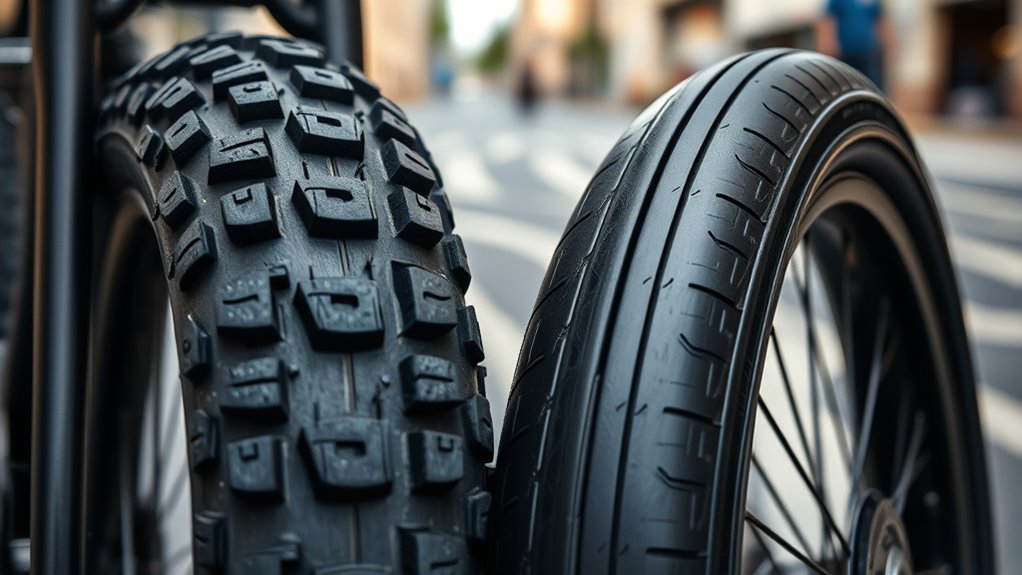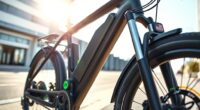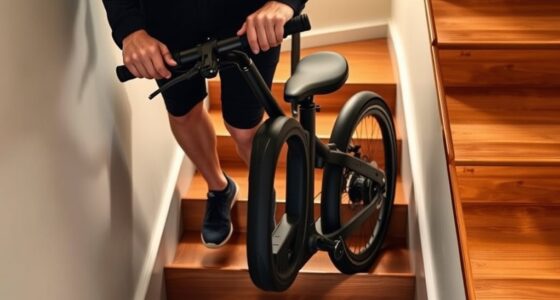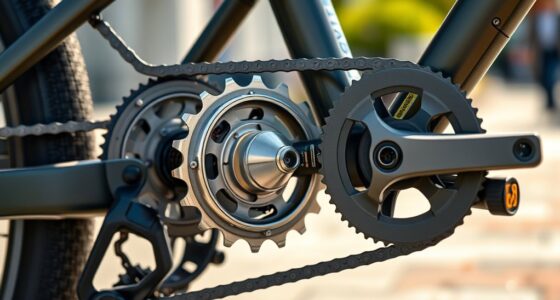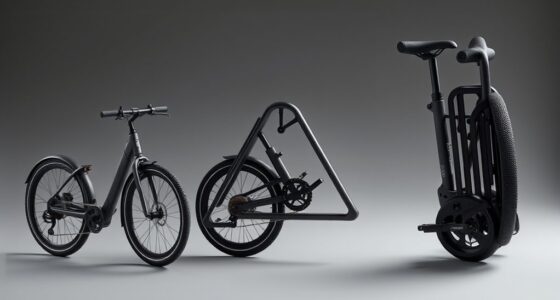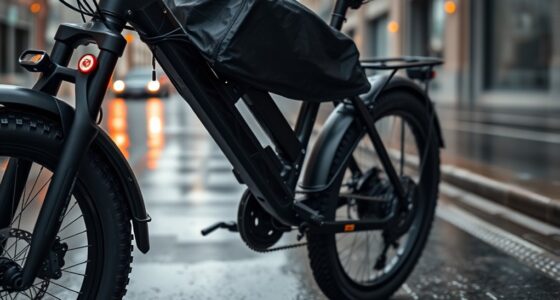Choosing the right tires for your small‑wheel e‑bike directly impacts your ride’s comfort, stability, and safety. Opting for proper tire pressure, tread pattern, and width helps absorb bumps, grip wet or rough terrain, and improve handling. Wider tires offer better shock absorption, while appropriate tread designs improve traction. By adjusting these factors to suit your typical routes, you can enjoy a smoother, more controlled ride. Keep exploring to discover how specific tire choices can enhance your e‑bike experience even further.
Key Takeaways
- Tire selection influences ride smoothness, comfort, and stability on small-wheel e-bikes by impacting shock absorption and control.
- Proper tire pressure balances softness and firmness, affecting ride quality and safety on different terrains.
- Tread pattern determines grip and handling, especially in wet or rough conditions, enhancing overall ride stability.
- Narrower tires offer speed and agility but transmit more vibrations, while wider tires improve shock absorption and comfort.
- Matching tire width, tread, and pressure to riding terrain optimizes ride quality and riding pleasure.
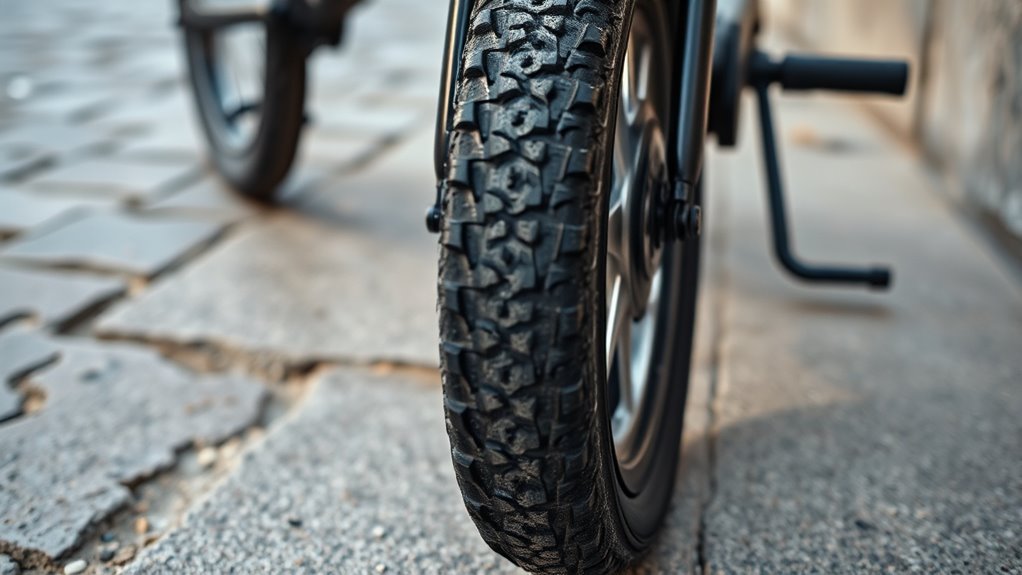
Choosing the right tires is crucial for optimizing ride quality on small-wheel e-bikes. The tires you select directly influence how smooth, comfortable, and stable your ride feels. Two critical factors to take into account are tire pressure and tread pattern. Proper tire pressure allows you to fine-tune the ride experience. If your tires are underinflated, you’ll notice a softer, bumpier ride as the tires absorb more shocks from uneven surfaces. Conversely, overinflation leads to a harsher ride, reducing grip and increasing the likelihood of punctures. Finding the right balance is key; usually, the recommended pressure range marked on the tire sidewall provides a good starting point. Adjusting tire pressure based on riding conditions—such as pavement, gravel, or wet surfaces—can greatly improve comfort and safety. Additionally, maintaining consistent tire pressure ensures optimal contrast ratio and overall performance of your ride. Tread pattern also plays a crucial role in ride quality. Small-wheel e-bikes often come equipped with tires suited for urban commuting or light off-road use, but understanding the tread design can help you optimize performance. Smooth, slick tires excel on paved roads, offering low rolling resistance and a quiet, efficient ride. If you frequently ride on rougher terrain or wet conditions, tires with more aggressive tread patterns provide better grip and stability. These tires typically feature deeper grooves or knobby designs that channel water away and grip uneven surfaces. Selecting a tread pattern that matches your typical riding environment ensures you enjoy a smoother, more controlled ride while minimizing slips or vibrations. In addition to these factors, think about the tire width. Wider tires tend to absorb shocks better, offering increased comfort, especially on bumpy surfaces. Narrower tires, while faster and more aerodynamic, might transmit more road vibrations, which can compromise comfort over long distances. Combining the right tire pressure with an appropriate tread pattern tailored to your riding style can make a noticeable difference in ride quality. For example, if you’re commuting daily on city streets, a tire with a moderate tread pattern and proper inflation will provide a balanced, comfortable experience. On weekend trail rides, switching to tires with more aggressive treads and adjusting your tire pressure for better grip will enhance your control and ride enjoyment. Ultimately, understanding how tire pressure and tread pattern interact helps you customize your small-wheel e-bike’s setup. Regularly checking your tire pressure and choosing tires suited for your usual terrain ensures each ride is as comfortable, safe, and efficient as possible. Your choice of tires isn’t just about speed or durability—it’s about creating a riding experience that feels just right for you.
Frequently Asked Questions
How Does Tire Pressure Influence Ride Comfort on Small-Wheel E-Bikes?
Lower tire pressure generally improves ride comfort on small-wheel e-bikes by providing better shock absorption, making your ride smoother. However, be cautious not to reduce it too much, as it can cause tire pinch flats or reduce efficiency. Higher tire pressure offers less rolling resistance and better handling but can lead to a bumpier, less comfortable ride. Find a balance that suits your riding style for ideal comfort.
Can Tire Tread Patterns Affect the Bike’s Handling on Different Terrains?
Think of tire tread patterns as your bike’s secret weapons, much like a knight’s armor adapting to different battles. They directly influence handling on various terrains, offering mud traction where needed and gravel grip on rough paths. A knobby tread excels in off-road conditions, providing stability and control, while a smoother pattern boosts efficiency on paved surfaces. Choosing the right tread pattern guarantees your ride remains confident and responsive across any terrain.
Are Tubeless Tires Better for Ride Quality Than Traditional Tubes?
Tubeless tires generally offer better ride quality than traditional tubes because they provide improved puncture resistance and a smoother ride. Plus, they tend to have greater tire durability due to better sealing and lower pressure options. When installing tubeless tires, follow specific installation tips like ensuring the rim is clean and using sealant properly. This setup minimizes flats and enhances comfort, making your ride more enjoyable and reliable.
How Often Should I Replace Tires to Maintain Optimal Ride Smoothness?
You should replace your tires every 1,000 to 2,000 miles, but don’t rely solely on mileage; pay attention to tire wear and tear. Tire longevity varies based on riding conditions, terrain, and maintenance. Regular inspections help catch cracks, bald spots, or embedded debris early. Timely replacement ensures ideal ride smoothness, safety, and performance, preventing unexpected flats or discomfort. Stay proactive—your ride’s quality depends on it.
Do Larger Tires Improve Shock Absorption on Small-Wheel E-Bikes?
Larger tires generally improve shock absorption on small-wheel e-bikes because they offer increased tire width, which cushions impacts better. Thicker tires with more flexible sidewalls reduce vibrations and make rides smoother, especially over rough terrain. However, keep in mind that wider tires may add weight and slightly affect handling. Choosing tires with softer sidewalls can enhance shock absorption even further, ensuring a more comfortable ride.
Conclusion
Choosing the right tires truly transforms your small-wheel e-bike experience. Some might worry about added weight or cost, but the improved ride quality and grip are worth it. Don’t let those concerns hold you back—investing in quality tires makes every ride smoother, safer, and more enjoyable. Plus, with the right setup, you’ll notice better handling even on rougher surfaces. So go ahead, pick tires that suit your riding style and feel the difference in every pedal stroke.
